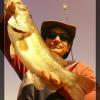T9 makes an excellent point.
You can choose to accept or dismiss Perry's assumptions about how and where the fish live and move. But the beauty of his system, as far as it's actual implementation is concerned, lies in the methodical manner in which the highest percentage spots are found and fished. Behind all of it's diagrams and scenarios that emphasize interpretation, at it's heart, It's really a technical system that focuses on the how-to. It can be easy to start over thinking all the data when you're out on the water; Clines, forage, fish suspension, water and weather conditions, etc. All of these things factor in to the whole to be sure. But if you start by just focusing on identifying the prime structures, and finding and fishing all of the breaks on them between shallow and deep, and do it in a systematic way, you'll be way ahead of the game. All the other stuff is fine tuning which you should only expect to dial-in over repeated visits to the location or with time on the water in general.
The Spoonplugging system in general, encourages you to stop trying to over-analyze and out-think the fish when you're on the water and just follow the "guidelines" that will, in time, lead you to the right spots and to the fish. Doing so develops your skills, your confidence, and your intuition. Whether you choose to adhere to it in the strictest sense like some of the puritans or to adapt it's guidelines to suit your style or inclinations is up to you in the end. Without a system of some sort though, to lead you to, and put you on the high percentage spots, you'll most likely end up constantly second-guessing yourself and wandering around. You'd probably be better off just following the shoreline and throwing your lures at all the same visible cover everyone else does.
~Denny








